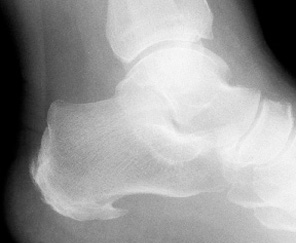The Plantar Fascia is a thick, dense, band of connective tissue that helps stabilize the foot and create its arches. It is anchored to the heel and runs forward to attach to all the toes, but most specifically to the big toe. If you pull up on your big toe, you will probably be able to feel a cable-like band of tissue on the bottom of the foot. This is the Plantar Fascia.
As mechanical stress is put on the foot during the gait cycle (man was not designed for concrete), the arch repeatedly flattens out. The collagen fibers that make up the thick, tendon-like, tissue on the bottom of the foot is under continual tensile stress as the Plantar Fascia pulls at its attachment points —- the base of the big toe, but more particularly, the heel.
f
Notice the heel spur on the x-ray above. CRITICAL POINT: Heel spurs do not cause pain. I repeat, a heel spur is not what is making your heel hurt to the point you are ready to have some back alley pseudo surgeon amputate your foot, because a peg would have to hurt far less! Bone grows in response to mechanical stresses placed on it, and scarred Plantar Fasciae become incredibly tight, which in turn places inordinate amounts of stress at its attachment point (heel). This causes the stressed portion of the bone to grow. Thus, a spur. When you get off of your feet, it feels good because you take the pressure off of the Plantar Fascia and it actually starts the healing process. However, each and every time that you get back up on your feet, you create micro-tears where the Plantar Fascia attaches to the calcaneus (heel). It is a constant cycle of micro-tears, adhesion — micro-tears, adhesion. The result? Chronic Pain.
Plantar Fasciitis is ridiculously simple to diagnose. If you have first-step-in-the-morning pain…….you’ve got it. The traditional medical approach offers us things like X-rays to tell us whether or not a heel spur is present (even though doctors have known for decades that heel spurs do not cause pain), anti-inflammation medications, cortico-steroid injections, platelet-injection-therapy, artho-tripsy and even surgery. We offer a better approach.
- Scar tissue treatment to the plantar fascia along with specialized stretches: Stretching programs often fail because the scar tissue and calcification in the thick plantar fascia is not broken up first (see FASCIAL ADHESIONS).
- Specific adjustments to the feet: There are more bones in one foot than in the entire spine. When these bones do not move freely in relationship to each other, the result is a continuation of the cycle of pain, dysfunction, and DEGENERATION.
- A good orthotic: All orthotics are not created equal! A good orthotic that is both flexible and rigid. We carry generic orthotics that will work well for many people (under 50 bucks). For certain types of feet (particularly very high or very fallen arches), you will almost certainly require a custom orthotic. We recommend custom orthotics by XTREME FOOTWERKS of Idaho Springs, CO. Proper orthotics help take pressure off of the plantar fascia by essentially becoming the arch.
- Good Nutrition: Firstly, if you are overweight you need to lose it. HERE IS HOW to do it quickly and effectively. Secondly, you need to eat an ANTI-INFLAMMATORY DIET. Thirdly, there are SPECIFIC NUTRITIONAL SUPPLEMENTS once you have the Tissue Remodeling done that will not only slow down inflammation, but actually promote healing of the ELASTIC, COLLAGEN-BASED CONNECTIVE TISSUES.
For more information, visit our PATIENT TESTIMONIAL PAGE. I also have a more comprehensive page on PLANTAR FASCIITIS.





Andy, my foot pain sound exactly like yours and I’ve tried all the same treatments with not much luck, going on for four years now. Have you had any success since posting this last May?
Hi
I am a 47 year old male who has lead a healthy and active life, participating in a variety of aerobic and anaerobic sports and past times. I currently cycle around sixty miles per week with no foot pain.
I have had, what was diagnosed as plantar fasciitis, for over six years. The pain is never first thing in the morning and never near the heel. It is always on the arch of the right foot on the left side and usually only occurs after walking a few hundred yards but is then constant.
This condition is getting worse rather than better. I have spent a fortune on podiatrists, soft tissue therapists, chiropractors and physiotherapists; all of whom have started by recommending a range of stretching exercises, given a range of manipulation and claimed that their methods would conquer the problem. I’ve also constantly worn orthotics for years. In the last four years I’ve also developed a pain at the base of my big toe in the same foot.
I also have had well controlled type 1 diabetes for 40 years.
Any good advice would be greatly appreciated.
Regards
Andy
Hello Andy,
Unfortunately, the person I would refer you to is here in the States (Colorado).
Sincerely,
Dr. Russ